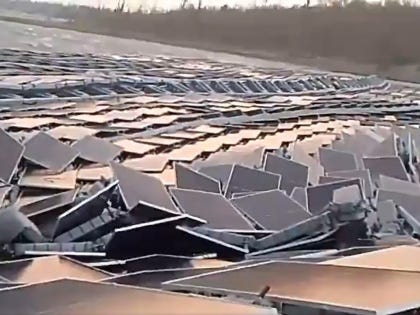CLIMATE FAILINTERMITTENT WIND AND SOLAROPINION The World’s Largest Floating Solar Farm Wrecked by a Storm Just Before Launch Eric Worrall
Greens keep telling us we can expect more frequent and extreme superstorms – so what is the point of building vulnerable floating structures?
Destroyed floating solar farm. Source Twitter, fair use, low resolution image to identify the subject.
CLIMATE FAILINTERMITTENT WIND AND SOLAROPINION
The World’s Largest Floating Solar Farm Wrecked by a Storm Just Before Launch
Essay by Eric Worrall
h/t Dr. Willie Soon; Who could have predicted acres of fragile floating structures would be vulnerable to bad weather?
Madhya Pradesh: Summer Storm Damages World’s Largest Floating Solar Plant at Omkareshwar Dam (Watch Video)
Indore: A summer storm on Tuesday damaged a floating solar plant at Madhya Pradesh’s Omkareshwar dam. The floating solar plant, situated in the backwater of the dam, is the biggest of its kind in the world. A joint venture between Madhya Pradesh Govt and National Hydroelectric Power Corporation (NHPC), the project was nearly completed and ready for its launch. A part of the project became operational last week.
The project near the village of Kelwa Khurd, aimed at generating 100 MW of electricity, with additional capacities of 88MW at Indawadi and 90 MW at Ekhand village. However, on Tuesday, summer storms with the speed of 50kmph hit the project and threw the solar panels all around the place. No employee was fortunately injured.
…
A video of the disaster;
Anyone who has ever owned a boat, particular a large boat which gets left in the water, knows what a harsh environment the sea can be. Some kind of failure was inevitable. If it hadn’t been a storm, there are plenty of other things which could have gone wrong.
Greens keep telling us we can expect more frequent and extreme superstorms – so what is the point of building vulnerable floating structures?
Plastics tend to disintegrate under tropical sunlight, especially when in contact with water or water spray. Ultraviolet from the sun drives exotic chemical reactions, which leads to chemical breakdown.
Metal sitting in water is difficult to manage, even stainless steel is not immune to corrosion. All metal structures in contact with water need to be protected with sacrificial anodes or comparable protective measures. Electricity and metal are an especially bad combination, any electrical fault which causes a current to run through metal in contact with water can cause corrosion to occur thousands of times faster than normal.
Let us hope developers and politicians take the hint, and stop throwing our money at inherently flawed ideas like floating solar arrays.





We're living in an "idiocracy."
The storm itself was moving along at 50 km/hr, or the wind speed was 50 km/hr. It looks more like the waves were the problem, not the wind. Even so, waves and wind are to be expected on a body of water.